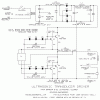OK Will, thanks for the responses. Here is the schematic, which I think is complete apart from the details of T1, and a photo of both sides of the board with component references that match those I assigned on the schematic.
Without the details of T1 I can't be too sure how the circuit works, but it's clearly an oscillator with a push-pull output, using two transistors on each side.
The humming noise you mentioned is probably quite normal. The whole circuit operates from bridge-rectified mains, with only 3 uF of smoothing, so its output voltage varies with the bridge-rectified mains voltage, which is at 120 Hz (assuming 60 Hz mains).
If one transistor is getting hot and the others aren't, I would suspect that transistor. Personally I would replace all four, unless they are prohibitively expensive. You're unlikely to do any damage by replacing just one, but the circuit may work better if they're all the same.
As I said, I think the NTE53 is probably the most suitable replacement. Most TO-3 transistors are not suitable.
I'd be happy to update the schematic with details of T1 if you are prepared to measure it.
Edit: Regarding replacement transistors. I should have said that (a) each pair of transistors (on the same heatsink) should be the same type, otherwise they won't current-share properly, and (b) you may have trouble finding a suitable replacement - power switching of this type is almost exclusively done with MOSFETs now, and has been for over a decade.
Digikey doesn't have ANYTHING suitable; Mouser does, but only three types in the TO-3 (metal can) package. These are BUX48, BUX48A, and 2N6547, all from STMicroelectronics and all around USD 6 each. Personally I would replace all four with 2N6547s from Mouser.







